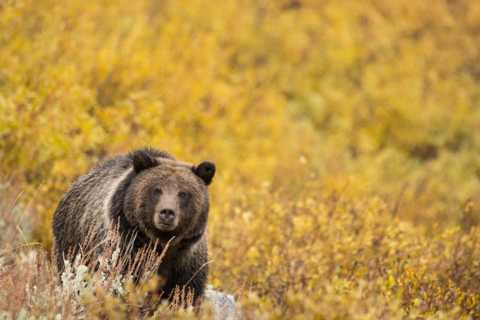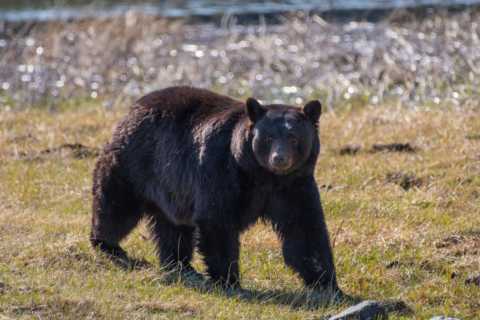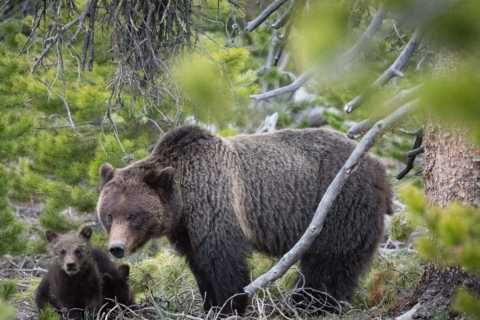The miracles and mysteries of bear hibernation

[caption id="attachment_1397" align="aligncenter" width="695"] All photos on this page were taken by Tanner Perkes, former Flat Creek Inn employee.[/caption]
As we speak, the bears in Yellowstone and Grand Teton parks are in their Thanksgiving dinner mode. They are consuming 20,000 calories per day so they will be prepared for their hibernation this winter. Hibernation is truly amazing. Picture yourself eating 5x the calories you normally do per day and gaining at least 50% of your body weight in one summer. Then in mid November, you curl up for a nice long winter rest, eating nothing and passing no waste for 5 months. Finally mid April, you climb out of bed with no loss of muscle tone and no loss of bone density. Sounds impossible, right? Yellowstone bears do it every year!
How do they do it? If we could figure out the chemical processes of hibernation, it could lead to medical breakthroughs like preventing osteoporosis and revolutionizing human organ transplants.
We do know that one key is a big drop in metabolism, we just don't know how it's initiated. With this drop in metabolism, the bear's heart rate and respiration slows and his blood circlulation becomes concentrated in his heart, lungs, and brain. Each day during hibernation, a bear needs water, protein, and 4000 calories. He gets the calories and water from stored fat and he gets his protein from muscles. But how do his muscles not waste away from being broken down into protein and also from disuse? And what happens to the urea that is created from the metabolic process? Amazingly, the urea is recycled into amino acids in the kidney and liver and makes proteins to replace muscle and other tissue. Basically, his kidneys and liver turn his urine into muscle. Wouldn't it be awesome if we could copy this process for human medicine?
All photos on this page were taken by Tanner Perkes, former Flat Creek Inn employee.[/caption]
As we speak, the bears in Yellowstone and Grand Teton parks are in their Thanksgiving dinner mode. They are consuming 20,000 calories per day so they will be prepared for their hibernation this winter. Hibernation is truly amazing. Picture yourself eating 5x the calories you normally do per day and gaining at least 50% of your body weight in one summer. Then in mid November, you curl up for a nice long winter rest, eating nothing and passing no waste for 5 months. Finally mid April, you climb out of bed with no loss of muscle tone and no loss of bone density. Sounds impossible, right? Yellowstone bears do it every year!
How do they do it? If we could figure out the chemical processes of hibernation, it could lead to medical breakthroughs like preventing osteoporosis and revolutionizing human organ transplants.
We do know that one key is a big drop in metabolism, we just don't know how it's initiated. With this drop in metabolism, the bear's heart rate and respiration slows and his blood circlulation becomes concentrated in his heart, lungs, and brain. Each day during hibernation, a bear needs water, protein, and 4000 calories. He gets the calories and water from stored fat and he gets his protein from muscles. But how do his muscles not waste away from being broken down into protein and also from disuse? And what happens to the urea that is created from the metabolic process? Amazingly, the urea is recycled into amino acids in the kidney and liver and makes proteins to replace muscle and other tissue. Basically, his kidneys and liver turn his urine into muscle. Wouldn't it be awesome if we could copy this process for human medicine?
 There's other fascinating physiological processes about hibernation. During hibernation, the bear's cholesterol levels are twice as high as during the summer and twice as high as the cholesterol levels of most humans. Bears, however, don't get hardening of the arteries or gallstones, because the bear's liver secretes a substance that dissolves gallstones. Another mystery is that bears do not lose bone mass during hibernation. All other mammals (including humans) when maintaining non-weight bearing positions for an extended period of time, suffer from osteoporosis, or a weakening of the bones. When we figure out the substance responsible for this phenomenon it could really change how we prevent and treat osteoporosis.
There's other fascinating physiological processes about hibernation. During hibernation, the bear's cholesterol levels are twice as high as during the summer and twice as high as the cholesterol levels of most humans. Bears, however, don't get hardening of the arteries or gallstones, because the bear's liver secretes a substance that dissolves gallstones. Another mystery is that bears do not lose bone mass during hibernation. All other mammals (including humans) when maintaining non-weight bearing positions for an extended period of time, suffer from osteoporosis, or a weakening of the bones. When we figure out the substance responsible for this phenomenon it could really change how we prevent and treat osteoporosis.
 Hopefully one day we will be able to harness the powers used during hibernation for human medicine. I found the following videos very helpful in learning more. Much of my information was found on the National Park site.
https://www.youtube.com/watch?v=WZSlABnPAPc
https://www.youtube.com/watch?v=LRcVLFL8doE
by Jessica Heath
Hopefully one day we will be able to harness the powers used during hibernation for human medicine. I found the following videos very helpful in learning more. Much of my information was found on the National Park site.
https://www.youtube.com/watch?v=WZSlABnPAPc
https://www.youtube.com/watch?v=LRcVLFL8doE
by Jessica Heath
 All photos on this page were taken by Tanner Perkes, former Flat Creek Inn employee.[/caption]
As we speak, the bears in Yellowstone and Grand Teton parks are in their Thanksgiving dinner mode. They are consuming 20,000 calories per day so they will be prepared for their hibernation this winter. Hibernation is truly amazing. Picture yourself eating 5x the calories you normally do per day and gaining at least 50% of your body weight in one summer. Then in mid November, you curl up for a nice long winter rest, eating nothing and passing no waste for 5 months. Finally mid April, you climb out of bed with no loss of muscle tone and no loss of bone density. Sounds impossible, right? Yellowstone bears do it every year!
How do they do it? If we could figure out the chemical processes of hibernation, it could lead to medical breakthroughs like preventing osteoporosis and revolutionizing human organ transplants.
We do know that one key is a big drop in metabolism, we just don't know how it's initiated. With this drop in metabolism, the bear's heart rate and respiration slows and his blood circlulation becomes concentrated in his heart, lungs, and brain. Each day during hibernation, a bear needs water, protein, and 4000 calories. He gets the calories and water from stored fat and he gets his protein from muscles. But how do his muscles not waste away from being broken down into protein and also from disuse? And what happens to the urea that is created from the metabolic process? Amazingly, the urea is recycled into amino acids in the kidney and liver and makes proteins to replace muscle and other tissue. Basically, his kidneys and liver turn his urine into muscle. Wouldn't it be awesome if we could copy this process for human medicine?
All photos on this page were taken by Tanner Perkes, former Flat Creek Inn employee.[/caption]
As we speak, the bears in Yellowstone and Grand Teton parks are in their Thanksgiving dinner mode. They are consuming 20,000 calories per day so they will be prepared for their hibernation this winter. Hibernation is truly amazing. Picture yourself eating 5x the calories you normally do per day and gaining at least 50% of your body weight in one summer. Then in mid November, you curl up for a nice long winter rest, eating nothing and passing no waste for 5 months. Finally mid April, you climb out of bed with no loss of muscle tone and no loss of bone density. Sounds impossible, right? Yellowstone bears do it every year!
How do they do it? If we could figure out the chemical processes of hibernation, it could lead to medical breakthroughs like preventing osteoporosis and revolutionizing human organ transplants.
We do know that one key is a big drop in metabolism, we just don't know how it's initiated. With this drop in metabolism, the bear's heart rate and respiration slows and his blood circlulation becomes concentrated in his heart, lungs, and brain. Each day during hibernation, a bear needs water, protein, and 4000 calories. He gets the calories and water from stored fat and he gets his protein from muscles. But how do his muscles not waste away from being broken down into protein and also from disuse? And what happens to the urea that is created from the metabolic process? Amazingly, the urea is recycled into amino acids in the kidney and liver and makes proteins to replace muscle and other tissue. Basically, his kidneys and liver turn his urine into muscle. Wouldn't it be awesome if we could copy this process for human medicine?
 There's other fascinating physiological processes about hibernation. During hibernation, the bear's cholesterol levels are twice as high as during the summer and twice as high as the cholesterol levels of most humans. Bears, however, don't get hardening of the arteries or gallstones, because the bear's liver secretes a substance that dissolves gallstones. Another mystery is that bears do not lose bone mass during hibernation. All other mammals (including humans) when maintaining non-weight bearing positions for an extended period of time, suffer from osteoporosis, or a weakening of the bones. When we figure out the substance responsible for this phenomenon it could really change how we prevent and treat osteoporosis.
There's other fascinating physiological processes about hibernation. During hibernation, the bear's cholesterol levels are twice as high as during the summer and twice as high as the cholesterol levels of most humans. Bears, however, don't get hardening of the arteries or gallstones, because the bear's liver secretes a substance that dissolves gallstones. Another mystery is that bears do not lose bone mass during hibernation. All other mammals (including humans) when maintaining non-weight bearing positions for an extended period of time, suffer from osteoporosis, or a weakening of the bones. When we figure out the substance responsible for this phenomenon it could really change how we prevent and treat osteoporosis.
 Hopefully one day we will be able to harness the powers used during hibernation for human medicine. I found the following videos very helpful in learning more. Much of my information was found on the National Park site.
https://www.youtube.com/watch?v=WZSlABnPAPc
https://www.youtube.com/watch?v=LRcVLFL8doE
by Jessica Heath
Hopefully one day we will be able to harness the powers used during hibernation for human medicine. I found the following videos very helpful in learning more. Much of my information was found on the National Park site.
https://www.youtube.com/watch?v=WZSlABnPAPc
https://www.youtube.com/watch?v=LRcVLFL8doE
by Jessica Heath 
